
|
acetic acid |
acetic acid is a lipid of Fatty Acyls (FA) class. Acetic acid is associated with abnormalities such as Vitamin B 12 Deficiency. The involved functions are known as Excretory function. The related lipids are Propionate. |
89633 |

|
Arachidonic acid |
Arachidonic acid is a lipid of Fatty Acyls (FA) class. Arachidonic acid is associated with abnormalities such as Atherosclerosis, Ischemia, Hypertensive disease, Hypertension induced by pregnancy and Vascular ring of aorta. The involved functions are known as Platelet aggregation, Anabolism, Ion Transport, Signal Transduction Pathways and Signal. Arachidonic acid often locates in Extracellular, Body tissue, Protoplasm, Tissue membrane and soluble. The associated genes with Arachidonic acid are CYP2J2 gene, CYP2E1 gene, Recombinant Proteins, POR gene and P4HTM gene. The related lipids are Fatty Acids, Glycerophospholipids, Steroids, octadecadienoic acid and 9-hydroxy-10,12-octadecadienoic acid. The related experimental models are Mouse Model and Knock-out. |
22864 |
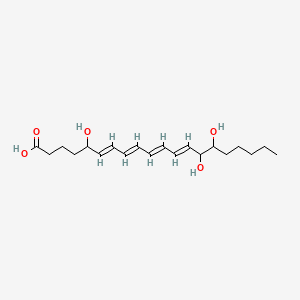
|
Lipoxin b |
Lipoxin b is a lipid of Fatty Acyls (FA) class. |
202 |
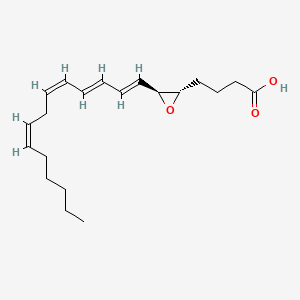
|
LTA4 |
Lta4 is a lipid of Fatty Acyls (FA) class. Lta4 is associated with abnormalities such as Myocardial Infarction. The involved functions are known as enzyme activity, Mutation, Lipid Binding, Neutrophil Activation and Inflammation. Lta4 often locates in Membrane, Extracellular and Cytosol. The associated genes with LTA4 are Locus, ALOX5AP gene, CIITA gene and TNFSF4 gene. The related lipids are Lipopolysaccharides. |
526 |
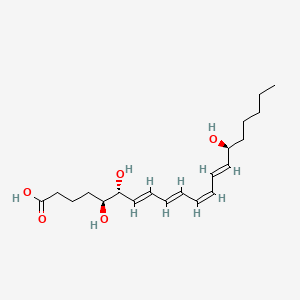
|
Lipoxin A4 |
Lipoxin a4 is a lipid of Fatty Acyls (FA) class. Lipoxin a4 is associated with abnormalities such as Asthma, Cystic Fibrosis, Pneumonia, Obesity and Septicemia. The involved functions are known as Inflammation, Signal, Signal Transduction, Regulation and Metabolic Inhibition. Lipoxin a4 often locates in Immune system, Blood, soluble, Extracellular and Splenic Tissue. The associated genes with Lipoxin A4 are FPR2 gene, Homologous Gene, SAA1 gene, Trp-Lys-Tyr-Met-Val-Met and Annexin 1. The related lipids are Steroids. The related experimental models are Knock-out. |
1240 |
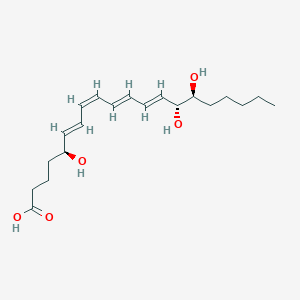
|
Lipoxin b4 |
Lipoxin b4 is a lipid of Fatty Acyls (FA) class. |
103 |
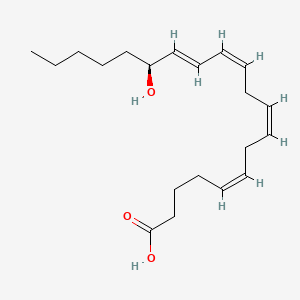
|
15S-HETE |
15s-hete is a lipid of Fatty Acyls (FA) class. 15s-hete is associated with abnormalities such as Ischemia and Vascular Diseases. The involved functions are known as Transcription, Genetic, Signal Transduction, tube formation, Angiogenic Process and Biochemical Pathway. 15s-hete often locates in Endothelium, Membrane, Cytoplasm, Body tissue and Protoplasm. The associated genes with 15S-HETE are RAC1 gene, ALOX15 gene, ALOX5 gene, Candidate Disease Gene and GAPDH gene. |
1011 |
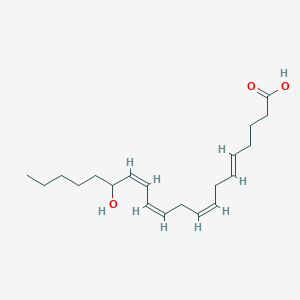
|
15-hete |
15-hete is a lipid of Fatty Acyls (FA) class. The involved functions are known as Inflammation, Signal Transduction, inhibitors, Obstruction and Adjudication. 15-hete often locates in Endothelium, Protoplasm, Cytoplasm, Cytoplasmic and Extracellular. |
725 |
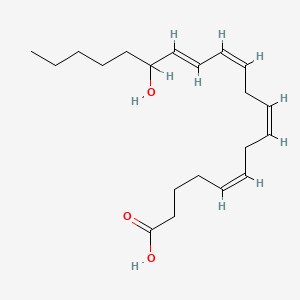
|
15-hete |
15-hete is a lipid of Fatty Acyls (FA) class. 15-hete is associated with abnormalities such as Endothelial dysfunction, Atherosclerosis, Risk factor, cardiovascular, hypercholesterolemia and Diabetes. The involved functions are known as uptake, Inflammation, Phosphorylation, Oxidation and Atherogenesis. 15-hete often locates in Endothelium, Cell surface, Protoplasm, Body tissue and Blood. The associated genes with 15-hete are CD36 gene, CCL2 gene, Orthologous Gene, SMAD2 gene and SMAD3 gene. The related lipids are 9-hydroxy-10,12-octadecadienoic acid and hydroxy fatty acid. |
725 |
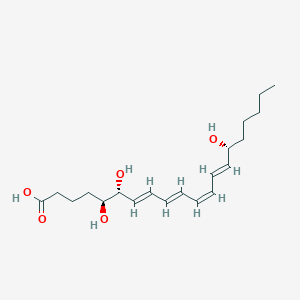
|
15-epi-lxa4;15r-lxa4 |
15-epi-lxa4;15r-lxa4 is a lipid of Fatty Acyls (FA) class. 15-epi-lxa4;15r-lxa4 is associated with abnormalities such as Pneumonia, Septicemia, Cystic Fibrosis, Subarachnoid Hemorrhage and Obesity. The involved functions are known as Protective Agents, Signal Transduction, cytokine biosynthesis, Inflammation and Anabolism. 15-epi-lxa4;15r-lxa4 often locates in Blood, Immune system and Heart tissue. The associated genes with 15-epi-lxa4;15r-lxa4 are IL2 gene, CXCL13 gene and CMKLR1 gene. The related lipids are Steroids. The related experimental models are Knock-out. |
305 |

|
Prostaglandin E2 |
Prostaglandin E2 is a lipid of Fatty Acyls (FA) class. Prostaglandin e2 is associated with abnormalities such as Renal glomerular disease, Arthritis, Degenerative polyarthritis, Pancreatitis and Rheumatoid Arthritis. The involved functions are known as enzyme pathway, Atherogenesis, Anabolism, inhibitors and Oxidants. Prostaglandin e2 often locates in Tissue membrane, Blood, Extracellular, Membrane and Protoplasm. The associated genes with Prostaglandin E2 are PTGS2 gene, TP53 gene, TNFRSF5 gene, FASTK Gene and TNF gene. The related lipids are Lipopolysaccharides, Steroids, monooxyethylene trimethylolpropane tristearate, Fatty Acids, Unsaturated and Promega. The related experimental models are Arthritis, Adjuvant-Induced, Xenograft Model, Experimental Autoimmune Encephalomyelitis, Cancer Model and Knock-out. |
49278 |

|
PGD2 |
Pgd2 is a lipid of Fatty Acyls (FA) class. Pgd2 is associated with abnormalities such as Inflammatory disorder, Pleurisy, Rhinitis, Dehydration and Pneumonia. The involved functions are known as antagonists, fat cell differentiation, Phosphorylation, Process and Gene Expression. Pgd2 often locates in Cell surface, Body tissue, Extracellular, Bone Marrow and Membrane. The associated genes with PGD2 are oxytocin, 1-desamino-(O-Et-Tyr)(2)-, P4HTM gene, PTGS2 gene, PTGDS gene and IL3 gene. The related lipids are 15-deoxyprostaglandin J2, Nonesterified Fatty Acids, Lipopolysaccharides, Steroids and Liposomes. The related experimental models are Knock-out and Rodent Model. |
6464 |

|
Leukotriene b4 |
Leukotriene b4 is a lipid of Fatty Acyls (FA) class. The involved functions are known as Chemotaxis, release of sequestered calcium ion into cytoplasm and Polymerization. Leukotriene b4 often locates in Protoplasm. The associated genes with Leukotriene b4 are phallacidin. |
9311 |
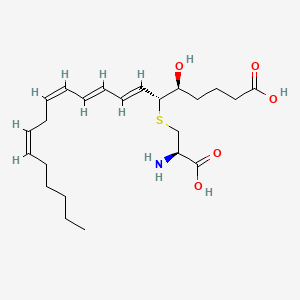
|
LTE4 |
Lte4 is a lipid of Fatty Acyls (FA) class. Lte4 is associated with abnormalities such as Asthma, Lung diseases, Eosinophilia, Respiration Disorders and Rhinitis. The involved functions are known as Anabolism, Increased Sensitivy, Process, Pathogenesis and Stimulus. Lte4 often locates in Membrane, Smooth muscle (tissue), Body tissue, Extracellular and Mucous Membrane. The associated genes with LTE4 are cystinylglycylglycine, FPR1 gene, PECAM1 gene, CCL3L1 gene and IL3 gene. |
1546 |
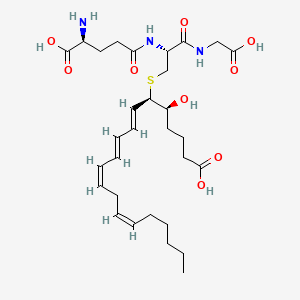
|
LTC4 |
Ltc4 is a lipid of Fatty Acyls (FA) class. Ltc4 is associated with abnormalities such as Asthma, Eosinophilia, Pulmonary Eosinophilia, Pneumonia and Cardiovascular Diseases. The involved functions are known as Signal, Gene Expression, Stimulus, Signal Transduction and Metabolic Inhibition. Ltc4 often locates in Plasma membrane, Cytoplasm, Back, Cytoplasmic and Tissue membrane. The associated genes with LTC4 are STIM1 gene, ABCC2 gene, CD9 gene, Mutant Proteins and Amino Acids, Aromatic. The related lipids are glycolithocholate. |
2252 |

|
Thromboxane b2 |
Thromboxane b2 is a lipid of Fatty Acyls (FA) class. Thromboxane b2 is associated with abnormalities such as endothelial dysfunction, Diabetes Mellitus, Non-Insulin-Dependent, Diabetes Mellitus, Ischemia and Thrombocytosis. The involved functions are known as Platelet Activation, Excretory function, Anabolism, Inflammation and mRNA Expression. Thromboxane b2 often locates in Endothelium, Hepatic and Microsomes, Liver. The associated genes with Thromboxane b2 are PTGS2 gene, prothrombin fragment 2 and CCL14 wt Allele. |
10175 |

|
Platelet activating factor |
Platelet activating factor is a lipid of Glycerophospholipids (GP) class. Platelet activating factor is associated with abnormalities such as Atherosclerosis, Acute cholecystitis without calculus, Cholecystitis, Colitis and Cholecystitis, Acute. The involved functions are known as Cell Survival, Metabolic Inhibition, lipid oxidation, Apoptosis and Oxidation. Platelet activating factor often locates in soluble, Cellular Membrane, Smooth muscle (tissue), Intima and Tissue specimen. The associated genes with Platelet activating factor are apolipoprotein A-I Milano, Homologous Gene, TSPO gene, HBEGF gene and SLC33A1 gene. The related lipids are Hydroxycholesterols, Liposomes, 25-hydroxycholesterol, Lysophosphatidylcholines and Lipopolysaccharides. The related experimental models are Knock-out, Mouse Model and Transgenic Model. |
7383 |

|
trichostatin A |
Trichostatin is a lipid of Polyketides (PK) class. Trichostatin is associated with abnormalities such as Dentatorubral-Pallidoluysian Atrophy, PARAGANGLIOMAS 3, abnormal fragmented structure, Disintegration (morphologic abnormality) and Hyperostosis, Diffuse Idiopathic Skeletal. The involved functions are known as Acetylation, Cell Differentiation process, histone modification, Gene Silencing and Transcriptional Activation. Trichostatin often locates in CD41a, Hematopoietic System, Chromatin Structure, Blood and Endothelium. The associated genes with Trichostatin are SPI1 gene, CELL Gene, Chromatin, CXCR4 gene and DNMT1 gene. The related lipids are Butyrates, Promega, butyrate, Lipopolysaccharides and Steroids. The related experimental models are Knock-out, Mouse Model, Xenograft Model and Cancer Model. |
5401 |

|
erythromycin |
erythromycin is a lipid of Polyketides (PK) class. Erythromycin is associated with abnormalities such as Systemic Inflammatory Response Syndrome, Pneumonia, Infection, Pneumococcal Infections and Exanthema. The involved functions are known as Pharmacodynamics, Sterility, Agent, Drug Kinetics and Adjudication. Erythromycin often locates in Blood, peritoneal, Extracellular, Ribosomes and apicoplast. The associated genes with erythromycin are P4HTM gene, SLC33A1 gene, FAM3B gene, Operon and Homologous Gene. The related lipids are Hydroxytestosterones, Steroids, Propionate, Mycolic Acids and campesterol. The related experimental models are Mouse Model and Knock-out. |
19871 |

|
clarithromycin |
clarithromycin is a lipid of Polyketides (PK) class. Clarithromycin is associated with abnormalities such as Helicobacter Pylori Infection, Infection, Coinfection, Gastritis and Peptic Ulcer. The involved functions are known as Point Mutation, Increased Sensitivy, Bacterial resistance, urease activity and Mutation. Clarithromycin often locates in Blood, Gastric mucosa, Biopsy sample, Respiratory System and Entire gastrointestinal tract. The associated genes with clarithromycin are Genes, rRNA, rRNA Operon, Genome, HM13 gene and GDF15 gene. The related lipids are 9,11-linoleic acid, Steroids, Lysophosphatidylcholines, Lipopolysaccharides and 4-hydroxycholesterol. The related experimental models are Mouse Model, Knock-out and Experimental Pneumococcal Meningitis. |
10449 |

|
nystatin |
nystatin is a lipid of Polyketides (PK) class. Nystatin is associated with abnormalities such as Virus Diseases, Infection, Candidiasis, Leukopenia and Mycoses. The involved functions are known as Membrane Potentials, Uptake, Flow or discharge, Cell membrane potential and adenine transport. Nystatin often locates in Cell Wall, Plasma membrane, Extracellular, Membrane and Virion. The associated genes with nystatin are Genome, Integral Membrane Proteins, Amino Acids, Basic, P4HTM gene and Homologous Gene. The related lipids are Sterols, Liposomes, Membrane Lipids, Sphingolipids and 1,2-oleoylphosphatidylcholine. The related experimental models are Knock-out and Xenograft Model. |
4890 |

|
(-)-Epigallocatechin gallate |
(-)-Epigallocatechin gallate is a lipid of Polyketides (PK) class. (-)-epigallocatechin gallate is associated with abnormalities such as IMMUNE SUPPRESSION, Infection, Nodule, Lymphopenia and Tumor Immunity. The involved functions are known as Apoptosis, Cellular Immune Response, Specific immune response, Signal and Infiltration. (-)-epigallocatechin gallate often locates in Immune system, Cytoplasmic Granules, Skin, Protoplasm and Body tissue. The associated genes with (-)-Epigallocatechin gallate are C8orf4 gene, Genes, vpr, MAPK8 gene, P4HTM gene and GAG Gene. The related lipids are Promega, Lipopolysaccharides, Palmitates, Fatty Acids and Sphingolipids. The related experimental models are Mouse Model, Xenograft Model, Transgenic Model, Experimental Autoimmune Encephalomyelitis and Arthritis, Collagen-Induced. |
6551 |

|
naringenin |
naringenin is a lipid of Polyketides (PK) class. Naringenin is associated with abnormalities such as Dehydration, Papillon-Lefevre Disease, BOSLEY-SALIH-ALORAINY SYNDROME, Cardiovascular Diseases and Atherosclerosis. The involved functions are known as Pigmentation, Biosynthetic Pathways, metaplastic cell transformation, 4-coumarate-CoA ligase activity and Pigment. Naringenin often locates in Body tissue, Cell Wall, Membrane, Cytoplasmic matrix and Tissue membrane. The associated genes with naringenin are Genome, Genes, Regulator, Alleles, Homologous Gene and SPEN gene. The related lipids are Fatty Acids, Total cholesterol, Lipopolysaccharides, Oleates and Cholesterol, Dietary. The related experimental models are Knock-out and Mouse Model. |
2420 |

|
forskolin |
Forskolin is a lipid of Prenol Lipids (PR) class. Forskolin is associated with abnormalities such as Cholestasis, Vocal cord dysfunction familial, Hypothyroidism, Renal tubular disorder and Disintegration (morphologic abnormality). The involved functions are known as Cell Proliferation, Anabolism, mRNA Expression, Agent and Signal. Forskolin often locates in Extracellular, Body tissue, Skin, Tissue membrane and Membrane. The associated genes with forskolin are P4HTM gene, SLC33A1 gene, NR1I2 gene, Genes, Reporter and CYP3A gene. The related lipids are Steroids, steroid sulfate, Fatty Acids, LYSO-PC and Lipopolysaccharides. |
24755 |
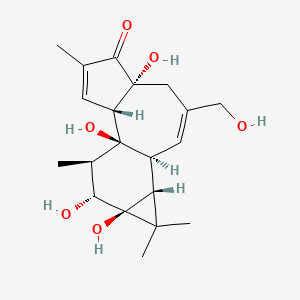
|
Phorbol |
Phorbol is a lipid of Prenol Lipids (PR) class. Phorbol is associated with abnormalities such as furuncle, Infection, endothelial dysfunction, Morphologically altered structure and Acute erythroleukemia. The involved functions are known as Tyrosine Phosphorylation, Metabolic Inhibition, Transcription, Genetic, Protein Biosynthesis and Signal. Phorbol often locates in Tissue membrane, Membrane, Cell surface, soluble and Cytoplasmic Domain. The associated genes with Phorbol are STAT3 gene, JAK2 gene, JUN gene, PROC gene and MAPK8 gene. The related lipids are Lipopolysaccharides, Phosphatidylserines, Liposomes, Fatty Acids and Octanols. |
2082 |

|
cholesterol |
cholesterol is a lipid of Sterol Lipids (ST) class. Cholesterol is associated with abnormalities such as Trypanosomiasis, Chagas Disease, Cleft Palate, Chondrodysplasia punctata 2, X-linked dominant and Child syndrome. The involved functions are known as Blood Circulation, Sterol Biosynthesis Pathway, Receptor Mediated Endocytosis, Methylation and Signal. Cholesterol often locates in Animal tissue, Blood, Membrane, Plasma membrane and peroxisome. The associated genes with cholesterol are MBD2 gene, SIM, SLC33A1 gene, Genome and NSDHL gene. The related lipids are Sterols, zymosterol, fecosterol, Total cholesterol and 7-dehydrocholesterol. The related experimental models are Mouse Model, Knock-out, Genetically Engineered Mouse and Disease model. |
98461 |

























